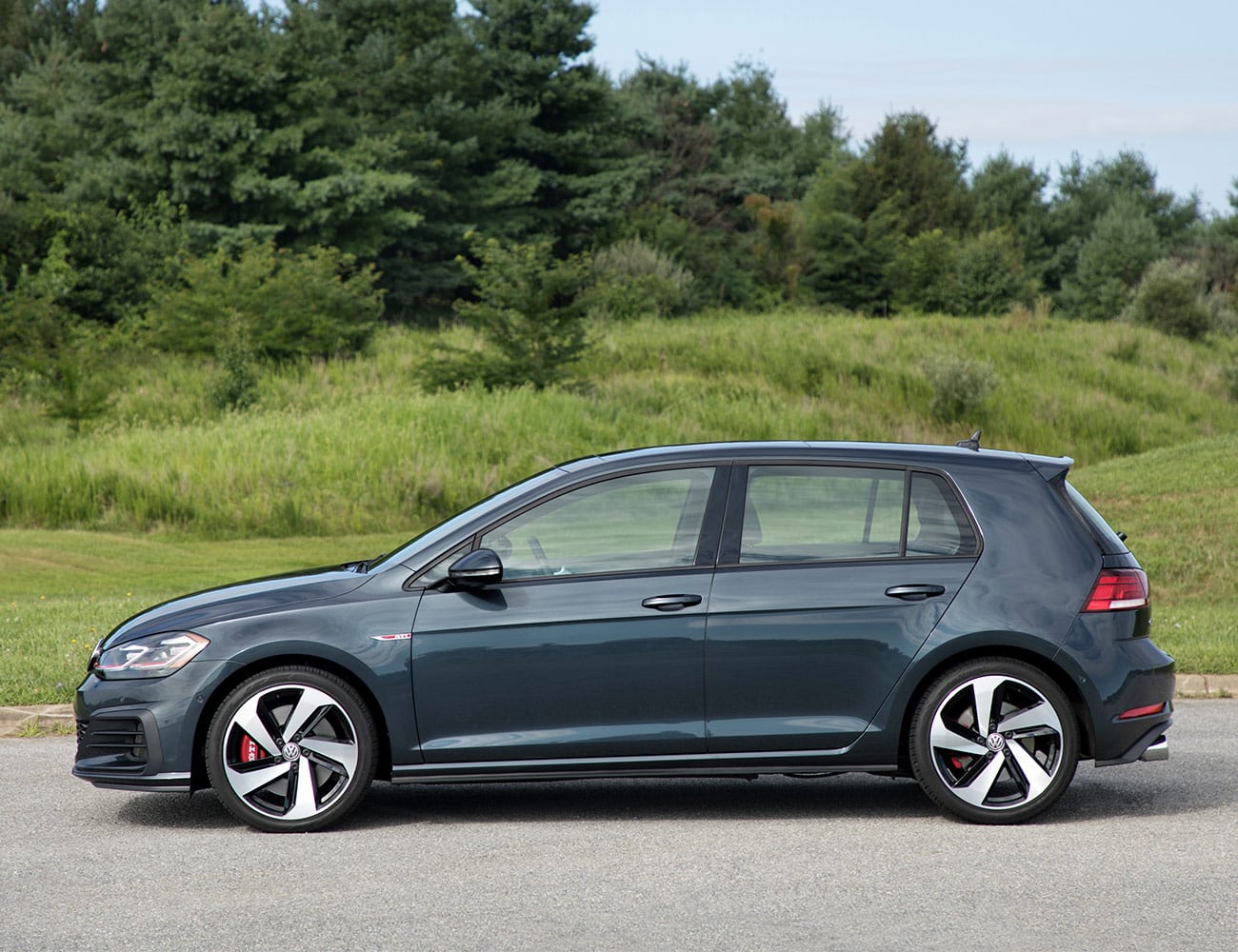• Base MSRP: $27,595
• 228 horsepower and 258 lb-ft of torque
• Exceptional balance and utility
• “The GTI is subtle and understated, a car for adults.”
The Volkswagen Golf, as James May noted in his BBC documentary series, is the preeminent people’s car. The well-regarded hatchback offers fun driving and practicality at an affordable price. The Golf has seen off all comers during a production run approaching 50 years. It killed off the old Beetle. It will bury the new Beetle, which, truth be told, was a Golf beneath its retro styling.
German engineers designed the Golf. So, it took all of a few minutes before someone inserted a more powerful engine, tuned it for racing and stumbled upon something brilliant. That brilliant creation became the Golf GTI. The Mk1 version debuting in 1975 became an icon, birthing a new market segment for the “hot hatchback.” The latest and perhaps greatest GTI, the Mk7, should prove a collectors’ item in its own right.
|
VW has come up with some goofy catchphrases for the current GTI. A brief sampling includes “the stylish hot hatchback” and “raw power, fully cooked,” whatever that means. The trouble stems from VW not being able to touch on what the Mk7 GTI is: perfection. Doing so would leave no reason to upgrade to the Golf R (raw power, burnt?). It would make buying a standard Golf or any other Volkswagen, by definition, imperfect.
The GTI has a proven basic formula: precise handling, peppy engine with strong torque and a smooth manual transmission. VW has refined that formula for 40-plus years. Some batches have been a touch weak, heavy or outmoded. But, the Mk7 came out just right, capturing all of the car’s heritage and accrued wisdom. It may be the best-balanced car on the road, not only for its price point.

With 228 horsepower and 258 lb-ft of torque, the GTI offers the exact power optimal for exuberant driving. You can push the GTI on real roads at speeds that won’t see you carted away in handcuffs. Automobile writers have extolled the car’s handling with every synonym of the word “sublime.” It rounds corners masterfully. Despite packing all that performance, the GTI is also still a Golf. You can park it easily, help a friend move and get a well-equipped base model for less than $30,000.
The GTI’s style exhibits its refinement. Other “hot” cars (the Honda Civic Type-R, for example) announce their presence like young rock stars, strutting around in the automotive equivalent of indescribably tight, red leather pants. The GTI is subtle and understated, a car for adults. It has a clean exterior and an elevated interior. What flair the GTI does offer – the red grille lipstick, the tartan seats, the golf ball shift knob – is traditional. You don’t know what you’re looking at with the GTI unless you know what you’re looking at.
The Mk8 GTI will arrive in 2020. Changes, mild and drastic, will be afoot. The best GTI we have yet seen – the current Mk7 – may be the best we ever get, or at least the purest incarnation of the GTI’s initial vision.
VW developed the new GTI during an awkward transition period. Dieselgate has cost Volkswagen AG $33 billion and counting, sapping resources and forcing a complete reorientation of production strategy. VW plans to phase out the combustion engine in 2026. Meanwhile, trucks and SUVs continue dominating the market. Plowing R&D into further perfecting an already perfect gasoline-powered hatchback, when well enough would do, makes little sense.
Golf sales have dipped in the U.S., so moving toward the market may work against getting an optimal GTI. To sell more Golfs, the hatchback will have to get longer and wider to be more viable families. The purist-favored three-door alignment may be scrapped altogether. We can presume VW won’t drop the manual (yet). But, development will go toward more fuel-efficient hybrid powertrains and improving the automatic transmission. VW has also hinted at a fully digital cockpit overhaul, which, if it does not annoy present buyers, will date the car, as technology tends to do, in the decades to come.

An MK7 GTI, tastefully modified for winter conditions – Photo: Hunter Kelley
If the base Golf goes more family-friendly, the Volkswagen likely would differentiate the GTI further by making it hotter. Expect more power. Ditto for more aggressive styling. The “Rabbit” and “Autobahn” trims, as well as the bevy of metallic paint options, may prove a harbinger of what is to come. It may be faster. Though, the balance and sophistication of the present model, not to mention the reasonable MSRP, may be difficult to preserve.
The Mk7 GTI arrived when Volkswagen was a car manufacturer and the best modern technology went toward producing an optimal driving experience. The Mk8 GTI will be a showcase for the Volkswagen Group’s broader ambitions as a mobility-oriented tech firm. The driver will always be connected, for better or more probably worse. We may get objectively more efficient and better-performing GTIs moving forward (and the climate will be better for it). But, they won’t feel the same.
Cars of the future will be electric or powered by other eco-friendly means. Many will be automated. Fewer than now will be individually owned. Driving a classic internal combustion car will be an expensive pastime, if not outlawed in some areas altogether (Aston Martin is prepping for that eventuality).
“Ludicrous” performance will be obtainable from EVs. The gas-powered cars that still resonate will be those that provide a unique, well-tailored and deep-rooted driving experience that disconnects the driver. The Mk7 GTI, perhaps the best Volkswagen creation to date, does that.
So, cover a Mk7 Volkswagen GTI in bubble wrap and store one in a climate-controlled garage, right? No. Save for retirement like a normal person. Use the GTI as the extraordinary daily driver it was designed to be.

